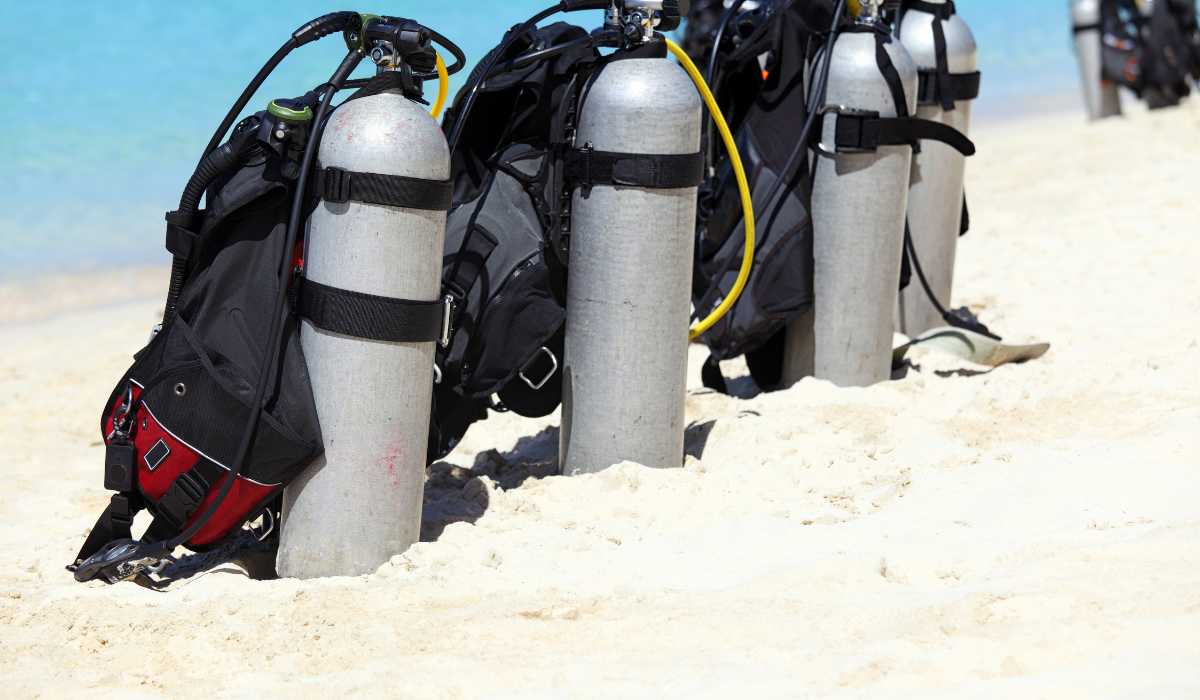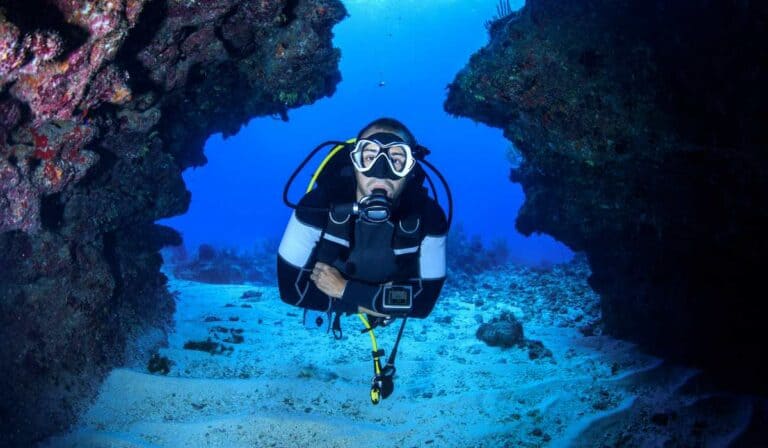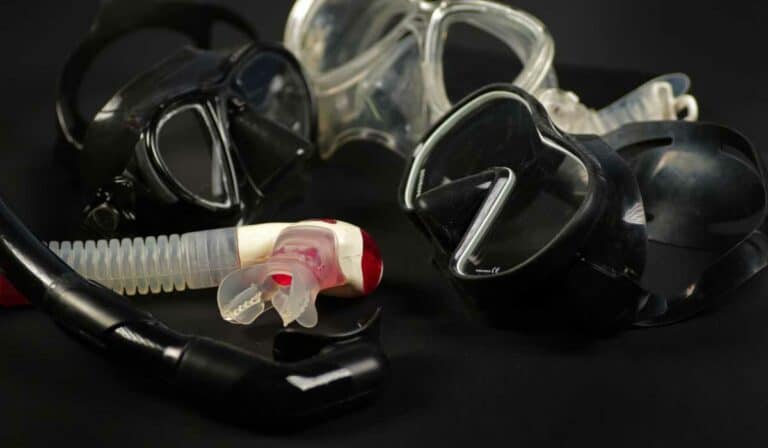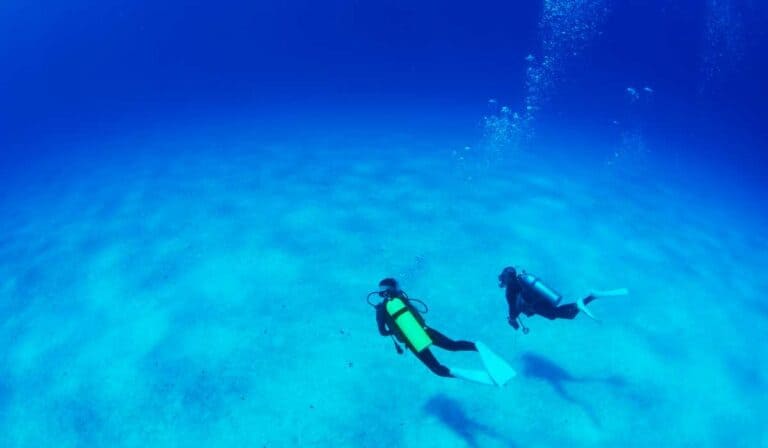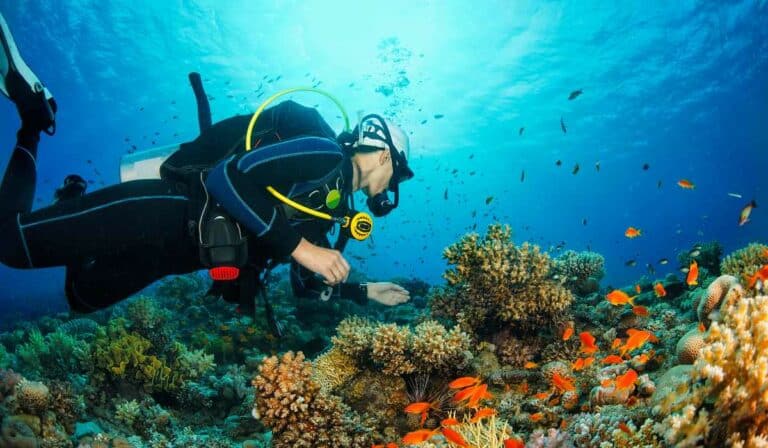The Costs Of Buying Your Own Scuba Equipment
Weighing the costs of acquiring your own scuba equipment requires consideration of a few elements. As an avid scuba diver, you’ll need to weigh the benefits and drawbacks of purchasing new or used gear, as well as estimate the total cost involved.
In this post, we will explore various aspects related to owning your own dive gear. We will discuss evaluating used vs new scuba equipment and estimating the total cost of acquiring all necessary items for a safe and enjoyable underwater experience.
Additionally, we will cover transporting your scuba gear while traveling, financing options available for purchasing expensive dive equipment, and maintenance costs associated with keeping your gear in top condition. By understanding these factors surrounding the costs of buying your own scuba equipment, you can make informed decisions that best suit your diving needs and budget.
Table of Contents
1. Evaluating Used vs New Scuba Equipment

When it comes to buying scuba equipment, one of the first decisions you’ll need to make is whether to purchase used or new gear. Considering the advantages and disadvantages of each, let’s explore which option is best suited to your scuba needs.
Pros of Buying Used Scuba Gear
- Cost Savings: The most obvious advantage of purchasing used scuba equipment is the potential for significant cost savings. You can often find quality gear at a fraction of its original price when shopping second-hand.
- Eco-Friendly: By choosing pre-owned items, you’re helping reduce waste and promote sustainability in the world of outdoor recreation.
- Variety: Shopping for used gear allows you access to a wider range of products from different brands and models that may no longer be available as new items on store shelves.
Cons of Buying Used Scuba Gear
- Limited Quality Assurance: When purchasing used equipment, there’s always some level of risk involved regarding its condition. It might not function properly or could require costly repairs down the line.
- No Warranty Coverage: Most manufacturers’ warranties don’t transfer between owners, meaning any issues with your pre-owned gear will likely come out of pocket.
- Availability: Finding specific pieces or sizes in good condition can sometimes be challenging when browsing through second-hand listings.
Tips for Purchasing Used Scuba Equipment
If you’ve decided to go the used route, here are some tips to help you find quality gear and avoid potential pitfalls:
- Buy from a reputable source such as a dive shop or online marketplace with seller reviews.
- Inspect the equipment thoroughly before purchasing. Look for signs of wear, corrosion, or damage that could affect its performance.
- Ask about service history, especially for items like regulators and BCDs. Regular maintenance is crucial for ensuring the safe operation of these components.
- Research the specific model you’re interested in to understand its features and any known issues.
Click here to read about Scuba Diving for Kids: An Exciting Way to Discover Nature
New Scuba Gear: The Benefits
If you prefer starting fresh with new scuba equipment, there are several advantages worth considering:
- Quality Assurance: Purchasing brand-new gear guarantees it’s in perfect working condition without any hidden defects or damages.
- Warranty Coverage: New scuba equipment typically comes with manufacturer warranties that protect against defects and malfunctions within a specified time frame.
- Latest Technology: By choosing new gear, you’ll have access to cutting-edge innovations designed to enhance your diving experience further.
Although buying used can save money upfront, investing in new scuba equipment may offer more peace of mind regarding safety and reliability. Ultimately, the choice between using vs. Deciding between pre-owned or fresh gear is a matter of individual inclination, economic capacity, and readiness to assume risk.
Key Takeaway:
For those looking to save money and have more options, buying used scuba equipment is an option; however, the lack of quality assurance and warranty coverage should be considered. While used gear can save you money and offer a wider variety, there are risks involved with limited quality assurance and no warranty coverage. On the other hand, investing in new scuba equipment guarantees quality assurance and warranty coverage for peace of mind regarding safety and reliability.
2. Estimating the Total Cost of Scuba Gear
Exploring the underwater realm of scuba diving can be a thrilling experience, but it’s critical to grasp the expenses associated with buying your own equipment. To help you make informed decisions about investing in scuba gear, we’ve broken down the estimated expenses for various essential items.
Tanks
A crucial component of any diver’s setup in their tank. Tanks can range from $150 to $600 depending on factors such as material (aluminum or steel), size, and brand. For a more economical option, an aluminum tank is typically less costly than steel.
Regulators
Your regulator is responsible for delivering air from your tank at a breathable pressure while underwater. Regulator prices vary based on features and quality; expect to spend anywhere between $200 and $1,000 for this vital piece of equipment. For those seeking high-quality regulators without breaking the bank, check out these top-rated options for under $500.
Wetsuits/Drysuits
To maintain comfort during dives in various water temperatures, divers need either wetsuits or drysuits – sometimes both. Wetsuit prices typically start around $100 for basic models but can reach up to several hundred dollars if you opt for higher-end materials like neoprene or advanced features like integrated hoods and gloves. Drysuit prices are significantly steeper due to their increased insulation capabilities; they generally cost between $1,000 and $3,000. Here’s a list of some of the best wetsuits available in different price ranges.
Fins, Masks, and Snorkels
These essential accessories help you navigate underwater with ease. Fins can cost anywhere from $30 to over $200 depending on factors like material (plastic or carbon fiber) and design (split or paddle). Masks range from around $20 for basic models up to over $100 for high-quality options with features like anti-fog lenses and comfortable silicone skirts. Snorkels typically start at about $10 but can reach upwards of $50 if you opt for advanced features such as dry tops or purge valves. Check out this guide on top-rated fins, masks, and snorkels.
Click here to read about 7 Best Places for Scuba Diving in the USA
Accessories & Safety Equipment
- Dive Computer: Essential for tracking dive time, depth, and air consumption rate; prices range between ~$200 – ~$1,500.
- Buoyancy Control Device (BCD): Helps maintain neutral buoyancy during dives; expect to spend between ~$300 – ~$800.
- Dive Light: Necessary for low-light conditions or night diving; costs vary widely (~$30 – ~$400).
- Safety Gear: Items such as surface marker buoys (SMBs), reels/spools (~$20 – ~$100), and dive knives (~$15 – ~$50) are crucial for diver safety.
Prices may differ based on brand, specs, and material quality. In total, you should expect to spend anywhere from $1,500 to over $5,000 for a complete set of scuba gear. While this may seem like a significant investment upfront, owning your equipment allows you the freedom to dive whenever and wherever you please without having to worry about rental fees or availability. Additionally, owning your gear can save you money in the long run if you dive frequently and would otherwise be paying rental costs. It’s also worth noting that owning your gear can help you avoid excess luggage fees when traveling to dive destinations.
Figuring out the overall expense of scuba gear can be a challenge, but with good research and planning it is possible to acquire quality items that stay within your financial plan. Transporting scuba gear can add additional costs depending on the type of vehicle used for transport and any other associated fees or taxes.
Key Takeaway:
This section breaks down the estimated costs of purchasing scuba gear, including tanks, regulators, wetsuits/drysuits, fins/masks/snorkels, and accessories/safety equipment. Prices may span from $1,500 to in excess of $5,000 for a full set of scuba gear contingent upon variables such as brand and condition. Owning your own gear can save you money in the long run if you dive frequently and would otherwise be paying rental costs.
3. Transporting Scuba Gear
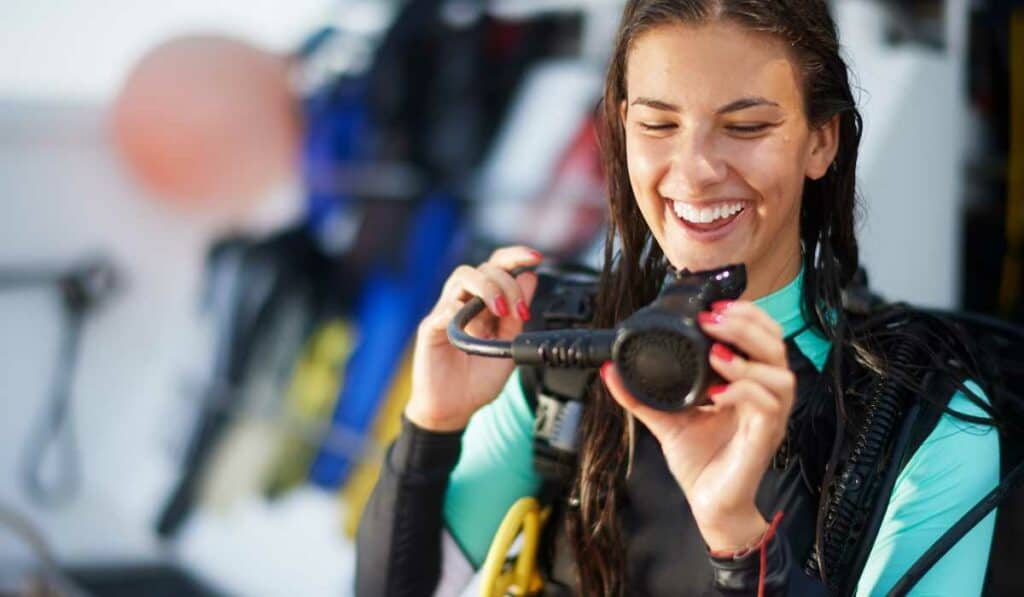
Before embarking on a scuba diving excursion, it is essential to consider how you will get your gear from one place to another. There are several methods for transporting scuba equipment while traveling, and each has its own set of advantages and challenges. In this section, we’ll explore some popular options such as checking it with airlines or renting a vehicle with enough space to accommodate your equipment.
Air Travel with Scuba Equipment
Flying to your dive spot can be the quickest route, but it may also pose difficulties when carrying scuba gear. Most airlines allow passengers to check their scuba equipment as part of their checked baggage allowance; however, additional fees may apply if you exceed weight limits or have oversized items like tanks.
To avoid any surprises at the airport, be sure to research TSA guidelines on traveling with sports equipment, as well as specific airline policies regarding size and weight restrictions for checked bags. It’s also a good idea to invest in durable travel cases designed specifically for protecting delicate pieces like regulators during transit.
- Pros: Convenient transportation method; protection from damage during transit (with proper packing)
- Cons: Additional fees may apply; risk of lost luggage or delays in arrival
Renting a Vehicle With Ample Space
If air travel isn’t feasible or you want more control over how your scuba gear is transported, renting a vehicle with ample space may be the ideal solution. This allows you not only flexibility in terms of packing and unpacking your gear but also the freedom to explore multiple dive sites during your trip.
When choosing a rental vehicle, consider factors such as trunk space, roof racks (for securing larger items like tanks), and overall size. A vehicle designed for outdoor enthusiasts may be best suited for this purpose.
- Pros: Complete control over transportation; flexibility in exploring multiple dive sites
- Cons: Additional costs associated with renting a vehicle; responsibility for loading and unloading equipment
Renting Scuba Gear at Your Destination
An alternative to transporting your own scuba equipment is renting it once you arrive at your destination. Many popular diving locations have reputable dive shops that offer rental services, allowing you to travel light while still enjoying the underwater world.
If you choose this option, be sure to research local dive shops ahead of time and read reviews from other divers about their experiences with the shop’s gear quality and customer service. Keep in mind that rented gear might not fit as well or feel as comfortable as your own equipment, so weigh these factors when making your decision.
- Pros: No need to transport heavy gear; potential cost savings on baggage fees or vehicle rentals
- Cons: Potential discomfort due to unfamiliar equipment; reliance on the availability of desired sizes/models at rental location
In conclusion, when it comes to transporting scuba gear, there are several options to consider. Whether you choose to check it with airlines, rent a vehicle, or rent gear at your destination, be sure to weigh the pros and cons of each method and choose the one that best fits your needs and budget.
Transporting scuba gear can be a tricky task, yet there are solutions that make it simpler. Financing your own equipment is another important consideration when diving into the world of scuba.
Click here to read about 12 Best Places for Scuba Diving in Florida
Key Takeaway:
This section explores the different options for transporting scuba gear, including checking it with airlines (with potential additional fees), renting a vehicle with ample space, or renting gear at your destination. Considering factors such as convenience, cost, and equipment familiarity is essential for choosing the best method of transporting scuba gear.
4. Financing Options for Scuba Gear
Despite the cost, you can still discover the amazing underwater world by exploring various financing options for scuba gear. Different financing solutions are accessible to assist you in obtaining your own scuba gear without compromising your budget. In this section, we’ll examine some popular methods for funding your gear purchases.
Credit Cards
Credit cards can be a convenient way to finance your scuba gear purchases, especially if you’re able to take advantage of promotional offers like 0% interest or cashback rewards. However, it’s essential to use credit responsibly and pay off your balance in full each month whenever possible; otherwise, high-interest rates could negate any savings on your equipment costs.
Personal Loans
If you prefer not to use credit cards or need a more substantial amount than what’s available through a card limit, personal loans may be another option worth considering. These loans typically have lower interest rates compared with credit cards and allow borrowers more time (usually several years) to repay their debt in manageable monthly installments.
Layaway Plans & Payment Installments
Some dive shops and online retailers offer layaway plans or payment installment options for customers looking to buy scuba gear over time rather than all at once upfront. This method allows divers-to-be more flexibility in managing their budgets while still working towards owning their own equipment eventually.
Renting vs Buying Equipment
- Renting: If you’re not ready to commit to purchasing your own scuba gear, renting equipment from a local dive shop or resort can be an affordable alternative. This option is particularly useful for those who only plan on diving occasionally or want to try out different types of gear before investing in their own set.
- Buying: On the other hand, if you’re serious about scuba diving and plan on participating regularly, owning your equipment may be more cost-effective in the long run. Plus, having your gear ensures proper fit and familiarity with its functionality – both crucial factors for safe and enjoyable dives.
In conclusion, financing options like credit cards, personal loans, layaway plans, and payment installments can help make buying scuba equipment more accessible for aspiring divers. However, it’s essential to weigh the pros and cons of each method carefully before committing so that you can enjoy underwater adventures without sinking into debt.
Financing choices for scuba equipment can be a beneficial method to manage the expense of procuring your own gear, enabling you to make the most of all that submerged investigation has available. Now let’s look at what kind of maintenance costs come along with owning and operating your own scuba gear.
Key Takeaway:
This section discusses the costs of buying scuba equipment and offers financing options such as credit cards, personal loans, layaway plans, and payment installments. It also compares renting vs buying equipment and suggests that owning your gear may be more cost-effective in the long run if you plan on diving regularly. The key takeaway is to weigh the pros and cons of each method carefully before committing to avoid sinking into debt while enjoying underwater adventures.
5. Maintenance Costs for Scuba Gear
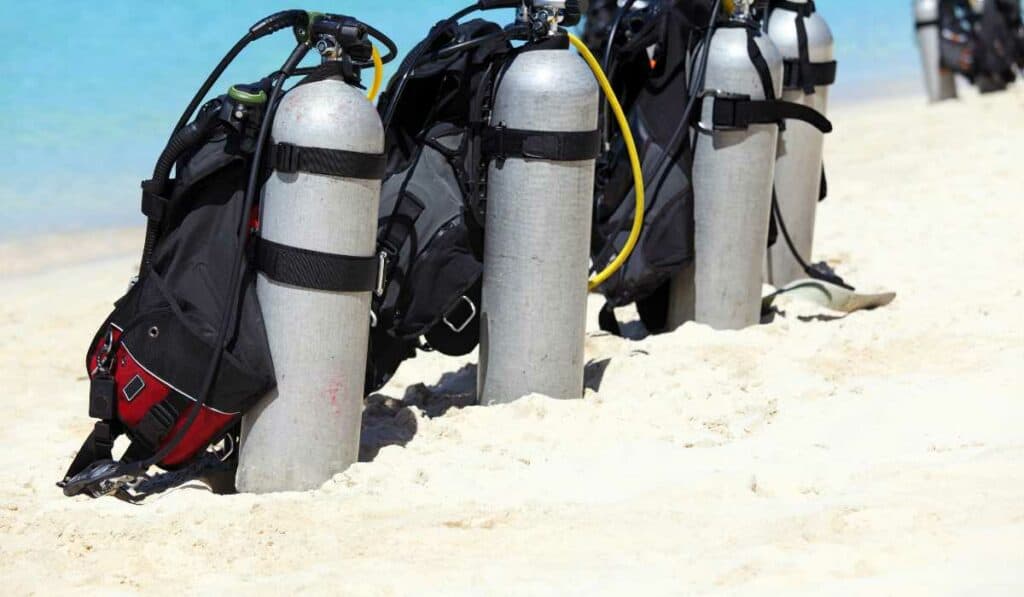
Possessing your own scuba apparatus necessitates the need to take care of it in order to guarantee its sturdiness and safety while diving. Regular maintenance is essential, as neglecting it can lead to equipment failure or even accidents underwater. In this section, we will discuss the ongoing maintenance costs associated with owning scuba gear such as servicing regulators and replacing worn-out parts.
A. Servicing Regulators
Servicing your regulator is one of the most crucial aspects of scuba gear maintenance since it ensures that you have a consistent air supply while diving. Most manufacturers recommend having your regulator serviced annually or after every 100 dives, whichever comes first. The expense for servicing a regulator can vary from $75 up to around $150, contingent upon your area and if any segments need substitution.
B. Replacing Worn-Out Parts
Over time, certain components of your scuba gear may wear out and require replacement for optimal performance and safety. Some common items that may need periodic replacement include:
- O-rings: These small rubber rings are used in various parts of your equipment like tanks, regulators, hoses, etc., to create watertight seals between different components; they usually cost around $1-$5 each.
- Hoses: Hoses connect various components like tank valves & regulators together; their prices vary based on length & material but generally range from $20-$50 per hose.
- Mouthpieces: A comfortable mouthpiece is essential when using a regulator; these can wear out over time and need replacement, costing around $5-$20 each.
- Mask straps: These hold your mask securely in place; they can become brittle or break with age and may need to be replaced at a cost of about $10-$15 per strap.
Click here to read about Scuba Divers: 7 Essential Ways To Save The Oceans For the Future
C. Additional Maintenance Costs
Beyond the costs mentioned above, there are other maintenance tasks that you should perform regularly to keep your scuba gear in top shape. Some examples include:
- Tank visual inspections: Tanks require an annual visual inspection by a certified technician to check for signs of corrosion or damage; this typically costs between $15-$30 per tank.
- Tank hydrostatic testing: Every five years (or as required by local regulations), tanks must undergo hydrostatic testing to ensure their structural integrity under pressure; this test usually costs around $40-$60 per tank.
- Battery replacements for dive computers & lights: Depending on usage, batteries for dive computers and underwater lights will eventually need replacing, which can range from a few dollars up to several hundred depending on the specific device model.
In conclusion, while owning your own scuba equipment offers numerous benefits such as comfort and convenience during dives, it also comes with ongoing maintenance costs that you should factor into your budget. By staying diligent with regular servicing and part replacements when needed, you’ll help ensure that your gear remains safe and reliable throughout its lifespan.
Key Takeaway:
Owning your own scuba gear will require maintenance, which is imperative for its extended life and safe utilization when diving. Regular maintenance is essential to ensure its longevity and safety during dives, including servicing regulators, replacing worn-out parts such as O-rings and hoses, tank visual inspections and hydrostatic testing, and battery replacements for dive computers & lights. These ongoing costs should be factored into your budget to keep your gear safe and reliable throughout its lifespan.
FAQs about The Costs of Buying Your Own Scuba Equipment
HOW MUCH DOES IT COST TO GET YOUR OWN SCUBA GEAR?
The cost of scuba gear varies depending on the quality and brand. On average, expect to spend around $1,500-$2,000 for a full set of equipment including a BCD, regulator, dive computer, wetsuit or drysuit, mask, fins, and snorkel. Additional accessories like dive lights or underwater cameras can increase the total cost.
Should I Buy My Own Scuba Equipment?
Purchasing your own scuba equipment is recommended if you plan on diving frequently or want personalized gear that fits comfortably. Owning your own gear ensures better hygiene and familiarity with its functionality.
However, if you only dive occasionally or travel extensively without space for bulky items in luggage, then renting may be more suitable.
Is It Worth Buying Your Own BCD?
Buying your own buoyancy control device (BCD) is worth considering if you’re an avid diver who values comfort and proper fit while underwater.
A personal BCD provides consistent performance during dives as well as easy adjustment options tailored specifically to individual preferences compared to rental units which might not offer such features.
CAN YOU BUY YOUR OWN SCUBA TANKS?
Yes, purchasing personal scuba tanks is possible but they require regular maintenance checks by certified professionals along with hydrostatic testing every five years at additional costs involved in the ownership process aside from the initial investment price point.
This option proves most beneficial when living near popular diving locations where tank rentals are limited or expensive, thus providing a convenience factor outweighing potential drawbacks associated with owning one’s cylinder(s).
Conclusion
In conclusion, buying your own scuba equipment can be a significant investment. It is important to consider the costs of purchasing new gear versus used gear and estimating the total cost including transportation, financing options, and maintenance expenses. While owning your own equipment may provide convenience and comfort in familiar gear, it is important to weigh the financial commitment against renting or borrowing from dive shops for occasional dives.

